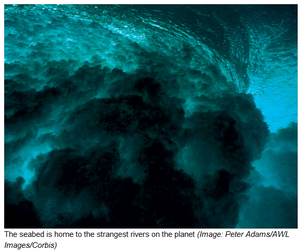
Global carbon cycling to a new level! The New Scientist published an article entitled: Cryptic river: The Torrents that flow beneath the seabed. It came out a couple months ago and it really caught my attention as a terrestrial river organic carbon geochemist. Below is a summary of what I got out of the article:
River geochemistry doesn’t end once it hits the ocean as underwater rivers travel thousands of kilometres beneath the ocean creating deep criss-crossing channels burying vast quantities of terrestrial organic carbon and delivering oxygen and sediment to the ocean depths. Quantification of how much carbon is transported and buried in these deposits and how that affects the global carbon cycle is a hot area in research.
Terrestrial river flow paths are dependent on the features of the surrounding geology and geomorphology. Underwater river flow paths, on the other hand, are dependent on other factors such a weakened gravitational force due to the water body itself pushing upwards and due to the Coriolis force which causesflow to be influenced by the rotation of the earth. For example, underwater rivers near the equator “wiggle” but near the poles underground rivers are much straighter. Often unnoticed at the ocean surface, these underwater rivers form abyssal channels and can be hundreds of meters deep and kilometres across. Telecommunications cables, which cross the oceans or seas, are snapped as huge sediment loads rush down the river like a pyroclastic cloud or an avalanche. This can cause communication blackouts to large regions. Unfortunately, mapping of these rivers and understanding where they are, why they’re there, and how fast they flow is a challenge. We actually know more about the channels on Mars and Venus than we do about the underwater channels in our own oceans. As the study of underwater rivers in the ocean is of key importance to improving telecommunications, the exploration of oil, and the understanding of global carbon cycling this area is ever growing.
River geochemistry doesn’t end once it hits the ocean as underwater rivers travel thousands of kilometres beneath the ocean creating deep criss-crossing channels burying vast quantities of terrestrial organic carbon and delivering oxygen and sediment to the ocean depths. Quantification of how much carbon is transported and buried in these deposits and how that affects the global carbon cycle is a hot area in research.
Terrestrial river flow paths are dependent on the features of the surrounding geology and geomorphology. Underwater river flow paths, on the other hand, are dependent on other factors such a weakened gravitational force due to the water body itself pushing upwards and due to the Coriolis force which causesflow to be influenced by the rotation of the earth. For example, underwater rivers near the equator “wiggle” but near the poles underground rivers are much straighter. Often unnoticed at the ocean surface, these underwater rivers form abyssal channels and can be hundreds of meters deep and kilometres across. Telecommunications cables, which cross the oceans or seas, are snapped as huge sediment loads rush down the river like a pyroclastic cloud or an avalanche. This can cause communication blackouts to large regions. Unfortunately, mapping of these rivers and understanding where they are, why they’re there, and how fast they flow is a challenge. We actually know more about the channels on Mars and Venus than we do about the underwater channels in our own oceans. As the study of underwater rivers in the ocean is of key importance to improving telecommunications, the exploration of oil, and the understanding of global carbon cycling this area is ever growing.
 RSS Feed
RSS Feed
